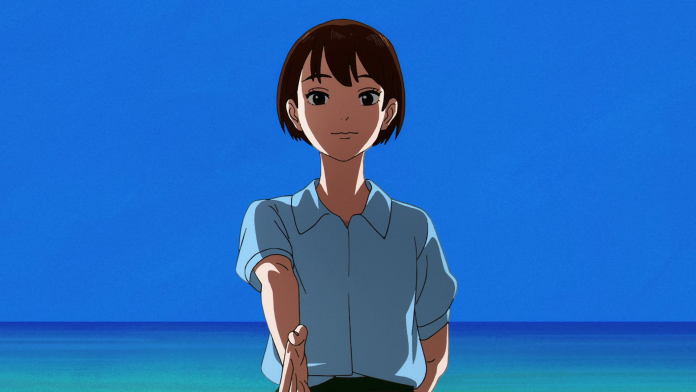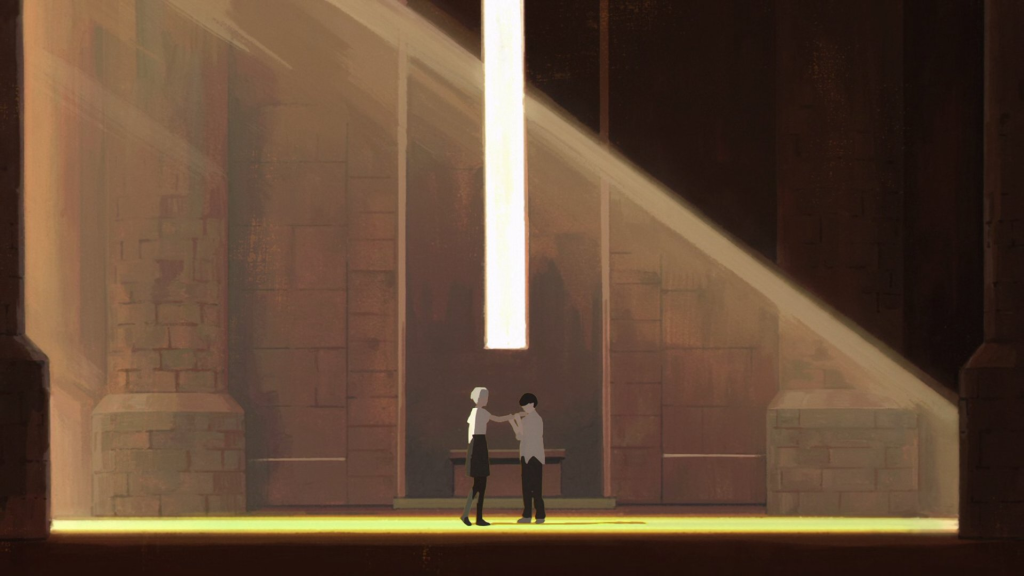Sonny Boy is a quiet and complicated story that looks into characters who have had their normal everyday lives uprooted. It’s an original anime created by writer and director Shingo Natsume (One-Punch Man, Space Dandy) that aired in Summer 2021. A story of how everything is meaningless until you place meaning into it yourself.
Isekai’d and stranded, these characters react in a spectrum of different emotions. Using abstract storytelling and reserved character writing, an idea that might sound simple when described like this becomes deeply layered and emotional. It helps that the worlds they are “adrift” in are also just as unique.
The contents of each world are built with deep symbolism. Worlds that reflect how characters and societies would deal with suddenly losing all meaning. To endlessly work toward returning home, unsure if all this effort will result in anything at all. This reflects working in the real world, where many of us work toward goals. To save money, to get a job, to create something. At the bottom of these mountains it feels incredibly hopeless.
With this in mind, it is an incredible decision to frame this story with our main character, who at the beginning is entirely goalless. Introverted, and with very few lines of dialogue, the first time we see Nagara is a cut of him laying on the ground. He has no intention of fighting back against his situation, in fact being transported into this world might feel relieving to him.
We see little to nothing of any of the character’s lives before going adrift, but from the small amount we see of Nagara’s life in episode 6 is enough to feel that he likely doesn’t have a positive life to return to.
In contrast we have our secondary main character Nozomi. A girl who is positive in the darkest of positions, smiling even when countering people she disagrees with. Nozomi dislikes power structures, fighting for her own freedom by making calm and reckless decisions. No matter the world she’d have to return to, she’d make the most of it.
Nagara’s hopelessness is likely what drew Nozomi to him in the first place. She wants to see him break out of his shell and do something fun or extroverted. Tearing up a school book, or saving a dying bird even when it may feel out of your control or none of your business.
The main purpose of Sonny Boy might be in this dynamic. It makes you feel that even though the future is uncertain, if your time spent working toward these goals is filled with stress and despair, you aren’t truly living at all. The final result of all of our lives are the same, you should live each day as positively as Nozomi.
Another tool Sonny Boy uses for storytelling is that the characters have special powers. These powers, same as the worlds the story visits, reflect the characters that possess them. Where Nagara’s power is to create worlds to escape into, you can pair it with Nozomi’s power and how it works like a compass to direct him back out of them.

This power, “Compass” also represents a part of Nozomi that struggles to find meaning. Episode 6 also reveals that in real life, Nozomi is no longer alive. She sees her friends grieving at her desk, and in future episodes it is clear that her positivity is far less bright. Her smile disappears in many scenes, and for once she seems concerned about the future. Though her fate is uncertain, she still wishes to direct her friends in the right direction.
Many interesting dynamics exist in Sonny Boy, making each interaction interesting even though its direction style is so reserved.
Breaking this reserved nature though, the show offers powerful scenes driven by music from its short, carefully curated and created soundtrack. Each episode has special songs of which either sonically or lyrically are created to suit the situations or characters in focus. There are times where the abstract visuals, incredible animation, and music fuse and make a scene that almost feels like a music video. To people who may even be media illiterate, these scenes will likely grab their attention and make for a fun experience. Songs like episode 6’s insert song “Let There Be Light Again” by Sunset Rollercoaster expresses Nozomi’s emotions, referencing her power directly as “light”. And near the end of the series, the tragic yet optimistic sounding insert song “Lightship” from episode 11 that represents Nozomi from Nagara’s perspective. How Nozomi guided him out of his shell, and about his grief now that she is gone.
Even though each episode is paced slowly allowing the situations the perfect amount of time to develop, the story still moves incredibly fast. Between episodes and some scenes a large amount of time passes. It is amazing that though this happens, it still does not feel like you are missing anything important. Every scene feels necessary.
None of these things are possible without an incredibly coordinated production. Director Shingo Natsume has an incredible passion in his work, and made very smart key decisions to ensure Sonny Boy was special. Selecting and arranging staff in a way that enabled passionate artist to frame the world in new and diverse ways. Each episode was given its own unique animation director, making every episode to feel different visually, proposing new stylistic ideas every week for a dynamic and fresh viewer experience.
This is most obvious in standout episodes like episode 8, “Laughing Dog”. Here Keiichiro Saito is allowed an incredible amount of freedom. Not only is he the animation director, but also the episode director, the storyboard artist, and he even contributed to the episode with some cuts of very impressive key animation.
The scenes he and the staff he brought to production create are cold and isolating. The drawn shapes are sharp and jagged. Depicting a sick and dying world through smart shape language, minimalism, and smart color direction. A particular scene that embodies this the most is Iwazawa Toru’s (岩澤亨) scene. Uncomfortably close, and grounded by realistic movements and harsh shapes. Shingo Natsume, having previously worked with Saito, knew that this sort of direction was a perfect fit for the tone of episode 8.
Distinct visually in each episode, incredible storyboarding, with a cast full of interesting characters, reserved writing, and well included music, Sonny Boy became one of my favorite stories. It made me cry several times and will probably continue to do so. Please consider watching the show if you haven’t already, or consider rewatching if you already have.








